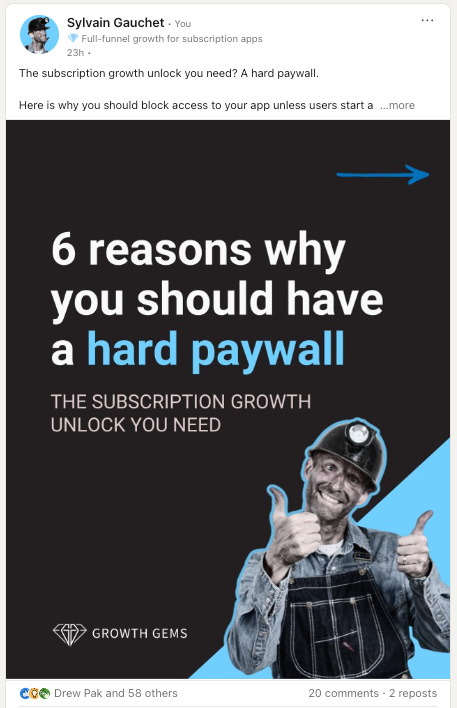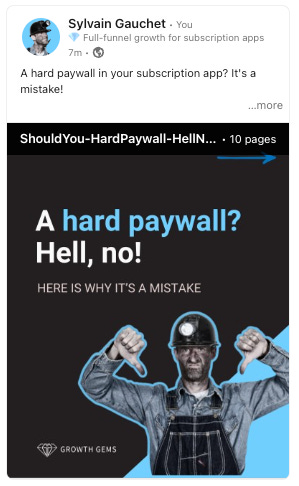💎 Should you have a hard paywall?
The pros and cons of a hard paywall based on your context, a decision matrix to know if you should prioritize a test, and tactics to mitigate the downsides if you do.
I’m baaack! I told you it wasn’t a strike. If you’re curious, here is what to expect from me moving forward.
Is a hard paywall the unlock you need?
By “hard” paywall, I’m referring to a paywall that blocks access to all features unless users start a free trial (or a subscription). This means they can't explore the app further without a free trial (or a subscription).
This comes in opposition to a “soft” paywall, i.e., a paywall users can close to get access to some freemium features.

Now, before we dive in, here’s how this post is laid out:
Hell, yes!
1. Focusing on higher-intent users pays off
With a hard paywall, you focus only on users with high intent. Why would you build something for users who are not even willing to start a free trial?
💎 When you launch your app, it’s the worst it will ever be. So start by locking your entire app (with a free trial) to get the users that have enough of a pain point to be willing to pay for that app. Those are the early users you want to be building for.
(15:27) by Jake Mor (CEO at Superwall) in Paywall Optimization and Best Practices
As Jake mentioned, this is particularly true if you’re getting started and haven’t found your initial product-market fit: it’s gold for user research.
2. Most users convert early or not at all
Subscription apps tend to capitalize on impulse by converting early in the journey.
Most trial starts occur on the first paywall, and most trial starts occur within the first 24 hours.
You won’t lose much by blocking access without a free trial, and you will likely still convert those that would have converted a little later.
3. Freemium experiences are not compelling enough
When you let users close your paywall and “explore” your app, and they get access to your free features, you take the risk that they don’t experience the true value of your app because :
It’s often a subpar experience
There isn’t only one aha moment that’s valid for all users.
💎 It’s unlikely that you’re going to be able to tell people what their Aha moment is and that the Aha moment is going to be the same for everybody. The Aha moment might very well be different for everybody.
(08:48)
💎 When we say “Aha moment”, it’s more like a series of realizations than one particular moment where lighting strikes and everything comes together.
(07:14)
By Samuel Hulick (Co-founder at Self-Serve SaaS) in Do “Aha Moments” Really Work?
4. Network effects are overrated
A hard paywall means no “free” users.
But network effects are overrated anyway.
Unless your app is specifically built for virality and network effects are at its core, your free user base won’t make a meaningful difference.
Ask around: word of mouth and referral loops rarely bring more than 15-20%.
5. More signal for Meta’s algorithm
Higher initial conversion rate to trial means you’re sending back more signal to Meta for optimization.
This will help you find more people interested in your product, which will decrease your cost per trial.
6. What you need the most is focus!
Last but not least…
Handling post-paywall experiences increases complexity.
A major trap of growing subscription apps is the lack of focus, and having a hard paywall is a great way to bring focus to one of your top growth levers: your onboarding (and paywall). And later, activation.
💎 Having a soft paywall means you have two flows, which decreases your focus as it gives many experimentation options. A hard paywall forces you to focus tests around the beginning of the funnel: number of screens during onboarding, prices, and subscription tiers.
(13:30) by Felix Boudreau (VP of Growth & Marketing at PokPok) in Hard Paywalls: How New Apps Can Thrive in a Crowded Category
Bonus point: it makes analytics easier as well. The “story” of user journey behavior gets much simpler to put together.
I’m missing something, or you want to back up these “Hell yes!” arguments? Join in on the LinkedIn discussion!
Hell, no!
1. You’re limiting your userbase
Not everybody is willing to convert “sight unseen”.
By not allowing users to close the paywall and explore/learn more about your app, you miss out on 80-90% of users.
You either convert users right away, or they’re lost (probably forever).
2. Reduced opportunities for converting, nurturing, and monetizing
Not experiencing your product (and definitely not creating a habit) means no future touchpoints.
How are you going to convert them to a subscription now?
You’re also preventing yourself from monetizing in other ways (ad monetization, smaller-commitment IAPs) and, later, addressing these non-converters’ pain point(s).
Good luck increasing your LTV and market size enough to really scale.
💎 The magic rule of freemium models is to balance increasing conversion with increasing free user retention. If the size of your free audience declines over time, the pool of users you can convert to your paid product decreases.
Finding the line between what is free vs. paid to achieve this requires a lot of iteration.
(27:40) by Paul Ganev (VP of Strategy, Analytics, and Marketing at Surfline) in How to Succeed with Freemium and Hybrid Monetization
3. Fewer users means less Word of Mouth
Since you have fewer users experiencing your product, you don’t give them a chance to share your product.
Adios social sharing or rewarding for sharing with friends.
Free users can be valuable as well!
💎 Free users are valuable to LoseIt! because they still create great business value by contributing to a large user base and generating organic word of mouth.
(03:42) by Erin Webster-Shaller (Vice President Marketing at Lose It!) in Achieving Mission & Profit with Freemium
4. Users don’t like it
If you listened to app store reviews, your app would be free, right?
You and I know that’s not possible, so we can’t pay too much attention to that noise…But a hard paywall brings it up a notch.
You’ll get backlash from the stores, your ratings will suffer, and you’ll hurt your rankings.
5. Store algorithms don’t like it
It’s commonly accepted that uninstalls and lack of engagement affect rankings, particularly on the Play Store.
You can find some articles on this here, here, and here (none with an official source).
With a hard paywall, you’re priming yourself for a higher percentage of uninstalls since there’s nothing else to do! This might penalize you on the stores.
One thing is for sure: you’re not getting app store ratings from people that delete your app right away.
6. Your trial-optimized UA campaigns will suffer
With a hard paywall, you don’t give users a choice, so you inflate install-to-trial because some will start a trial “just to see”.
Most users who feel forced to start a trial will cancel (and a lot will do so immediately), and you’ll decrease your trial -> subscription conversion rate.
Here’s how Marcus Burke puts it in this RevenueCat article:
Meanwhile, you’re optimizing your Meta/TikTok/Google campaigns for a free trial event, possibly without a good read on channel-level performance. The networks’ algorithms are crushing it, giving you exactly what you’re asking for: more free trials.
But you’re entering a vicious cycle: you’re sending lower intent signal, and end up getting more of these trial cancellers.
I’m missing something, or you want to back up these “Hell, no!” arguments? Join in on the LinkedIn discussion!
It depends…Here’s how to choose.
Of course, it depends!
Let’s try to break this down by growth stage.
Tactics to mitigate the downsides of hard paywalls
You already have a hard paywall or decided to prioritize a test?
I detailed the tactics I know in order to mitigate the cons and maximize the impact in the post below👇
🔗 Sources:
Paywall Optimization and Best Practices (RevenueCat webinar)
Do “Aha Moments” Really Work? (Self-Serve SaaS podcast)
Hard Paywalls: How New Apps Can Thrive in a Crowded Category (MAU webinar)
How to Succeed with Freemium and Hybrid Monetization (Sub Club podcast)
Achieving Mission & Profit with Freemium (Sub Club podcast)
How to increase trial conversion rates without adding new features (RevenueCat article)
But also…
15 years in the mobile app industry
5 years in growth at Babbel (language learning app)
Hundreds of growth webinars and podcasts “mined” for insights 💎
I hope this helps you decide what to prioritize for maximum impact.
Stay curious!
— Sylvain
Chief Insights Miner at Growth Gems ⛏️
(Fractional) Head of Growth at Reading.com
Growth Consultant/Advisor for high-potential subscription apps (hit reply if you want to chat - bonus if you’re in Education, Meditation & Cooking categories)
Acknowledgments 🙏
Huge thanks to the friends/peers/subscribers that have given me feedback and/or helped me put this edition together: Thomas Petit, Kurtis Morrison, Ekaterina Gamsriegler, Jakub Chour, Jeff Wang, Baptiste Malaguti, Leopold Riola, Teresa Mayede, Kristijan Arsov, Jacob Rushfinn, Marcus Burke, Andreas Kambanis, Kristóf Szabó, Felix Boudreau, Ankit Nayal…And everybody else I might be forgetting.


















love the format you got some great graphics in here too fam...but aren't hard paywalls technically against Apple HIG?